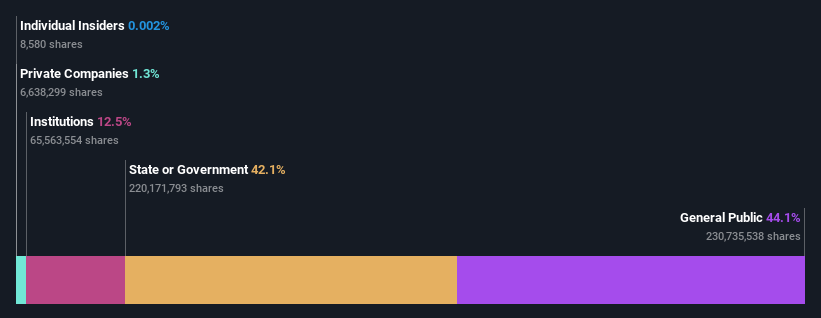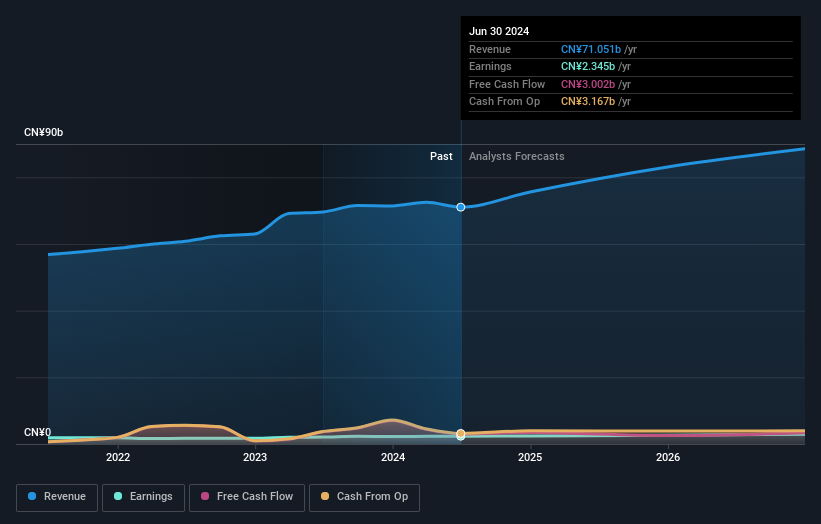Lao Feng Xiang Co., Ltd.'s (SHSE:600612) stock price dropped 8.7% last week; retail investors would not be happy

Key Insights
- The considerable ownership by retail investors in Lao Feng Xiang indicates that they collectively have a greater say in management and business strategy
- The top 9 shareholders own 50% of the company
- Institutional ownership in Lao Feng Xiang is 13%
If you want to know who really controls Lao Feng Xiang Co., Ltd. (SHSE:600612), then you'll have to look at the makeup of its share registry. The group holding the most number of shares in the company, around 44% to be precise, is retail investors. Put another way, the group faces the maximum upside potential (or downside risk).
As a result, retail investors as a group endured the highest losses last week after market cap fell by CN¥2.9b.
Let's take a closer look to see what the different types of shareholders can tell us about Lao Feng Xiang.
View our latest analysis for Lao Feng Xiang

What Does The Institutional Ownership Tell Us About Lao Feng Xiang?
Institutional investors commonly compare their own returns to the returns of a commonly followed index. So they generally do consider buying larger companies that are included in the relevant benchmark index.
As you can see, institutional investors have a fair amount of stake in Lao Feng Xiang. This suggests some credibility amongst professional investors. But we can't rely on that fact alone since institutions make bad investments sometimes, just like everyone does. It is not uncommon to see a big share price drop if two large institutional investors try to sell out of a stock at the same time. So it is worth checking the past earnings trajectory of Lao Feng Xiang, (below). Of course, keep in mind that there are other factors to consider, too.

Lao Feng Xiang is not owned by hedge funds. State-owned Assets Supervision and Administration Commission of Shanghai Municipal Government is currently the largest shareholder, with 42% of shares outstanding. Meanwhile, the second and third largest shareholders, hold 1.8% and 1.3%, of the shares outstanding, respectively.
We did some more digging and found that 9 of the top shareholders account for roughly 50% of the register, implying that along with larger shareholders, there are a few smaller shareholders, thereby balancing out each others interests somewhat.
While studying institutional ownership for a company can add value to your research, it is also a good practice to research analyst recommendations to get a deeper understand of a stock's expected performance. There are plenty of analysts covering the stock, so it might be worth seeing what they are forecasting, too.
Insider Ownership Of Lao Feng Xiang
The definition of an insider can differ slightly between different countries, but members of the board of directors always count. The company management answer to the board and the latter should represent the interests of shareholders. Notably, sometimes top-level managers are on the board themselves.
I generally consider insider ownership to be a good thing. However, on some occasions it makes it more difficult for other shareholders to hold the board accountable for decisions.
Our most recent data indicates that insiders own less than 1% of Lao Feng Xiang Co., Ltd.. However, it's possible that insiders might have an indirect interest through a more complex structure. It is a pretty big company, so it would be possible for board members to own a meaningful interest in the company, without owning much of a proportional interest. In this case, they own around CN¥388k worth of shares (at current prices). It is good to see board members owning shares, but it might be worth checking if those insiders have been buying.
General Public Ownership
The general public-- including retail investors -- own 44% stake in the company, and hence can't easily be ignored. While this size of ownership may not be enough to sway a policy decision in their favour, they can still make a collective impact on company policies.
Next Steps:
I find it very interesting to look at who exactly owns a company. But to truly gain insight, we need to consider other information, too.
I always like to check for a history of revenue growth. You can too, by accessing this free chart of historic revenue and earnings in this detailed graph.
Ultimately the future is most important. You can access this free report on analyst forecasts for the company.
NB: Figures in this article are calculated using data from the last twelve months, which refer to the 12-month period ending on the last date of the month the financial statement is dated. This may not be consistent with full year annual report figures.
New: AI Stock Screener & Alerts
Our new AI Stock Screener scans the market every day to uncover opportunities.
• Dividend Powerhouses (3%+ Yield)
• Undervalued Small Caps with Insider Buying
• High growth Tech and AI Companies
Or build your own from over 50 metrics.
Have feedback on this article? Concerned about the content? Get in touch with us directly. Alternatively, email editorial-team (at) simplywallst.com.
This article by Simply Wall St is general in nature. We provide commentary based on historical data and analyst forecasts only using an unbiased methodology and our articles are not intended to be financial advice. It does not constitute a recommendation to buy or sell any stock, and does not take account of your objectives, or your financial situation. We aim to bring you long-term focused analysis driven by fundamental data. Note that our analysis may not factor in the latest price-sensitive company announcements or qualitative material. Simply Wall St has no position in any stocks mentioned.
About SHSE:600612
Lao Feng Xiang
Operates in the jewelry industry in the People's Republic of China and internationally.
Flawless balance sheet 6 star dividend payer.

